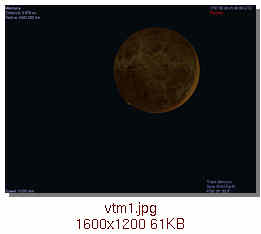Page 1 of 1
Venus Occults Mercury in 1737
Posted: 29.12.2002, 20:22
by selden
or "What's Wrong with This Picture?"
On May 28, 1737, John Bevis observed portions of the passage of Venus in front of Mercury from Greenwitch Observatory.
Here's Celestia's image of that event, as if viewed from the location of Greenwitch. A small part of Mercury can be seen past the lower left edge of Venus.

(this is a link to a high resolution image.)
A puzzle for the viewer: what is wrong with Celestia's presentation of this event?
Hint: similar problems are present, although not quite so obvious, in the other images of transits that I've posted today.
(No, it's not that I left off the cloud layer of Venus. That's an artistic decision.)
Posted: 29.12.2002, 21:47
by Malcolm
Ummmm, I could be about to make a fool of myself here ! ,,,
with a thin crescent illuminated Venus it must be at (eastern?) elongation (is that the right name for it?) ie. about as far away from the sun as it can get. But Mercury never gets that far away.
Posted: 29.12.2002, 21:51
by Malcolm
Ah, no, I am a fool ! and I cant edit my post!
at elongation it would be half illuminated doh!
but summat does not look right with the illumination/ phase of the two.
Posted: 30.12.2002, 02:28
by selden
Malcom,
You're warm, but not quite there. The phases are OK as best I can tell.
I do have "Ambient Light" turned on, but that's another "artistic license" thing. Sorry: I didn't intend that to be misleading.
Hint: the particular wrongness I have in mind is indeed a technical/astronomical issue.
(You need to be registered and logged in in order to be able to edit your posts.)
Posted: 30.12.2002, 12:22
by Calculus
Playing with this kind of events myself, I've noticed that Celestia doesn't render accurately the difference of magnitude. Venus should be a lot brighter than Mercury.
There is also a problem with the earth atmosphere which is differently rendered when you look at the dark sky vs a planet. (But this is not visible on your picture).
And of course there is still the light travel delay problem. Hopefully Chris will eventually fix it (is this right Chris?).
Posted: 30.12.2002, 14:53
by selden
o.O
I was thinking of the light delay problem, actually.
When you compare the timing of the occultation with other descriptions, Celestia shows it happening quite a bit earlier, and (presumably as a result) Mercury isn't completely obscured. In particular, see the Guide animation at
http://www.go.ednet.ns.ca/~larry/planets/1737occl.htm
I avoided the atmosphere obscuration by going up above it. An altitude of 50 km often seems to be enough

and it usually doesn't make any observable difference in the transits.
Posted: 07.01.2003, 18:21
by Calculus
Right Celestia is the very best tool to render Celestial Phenomena.
The only drawbacks are now:
1- light time delay
2- issuance of the accurate version for jupiter/saturn/pluto moons
3- all rendering options available on more videocards
4- the dust comet tail
There are a lot more to make it very convenient but it'd become a commercial software.
Does anyone (Chris) have an idea on when these calculation bugs will be available (1,2) ?
Posted: 07.01.2003, 19:14
by selden
Paul,
If by "calculation bugs" you're referring to your item #2, then it looks like most of them have been solved for v1.2.5. (See the Celestia developers mailing list archive on SourceForge.) Hopefully the formal release will be available soon.
Light-time delays may take a while longer...
ahem
 (this is a link to a high resolution image.)
(this is a link to a high resolution image.)
 (this is a link to a high resolution image.)
(this is a link to a high resolution image.)